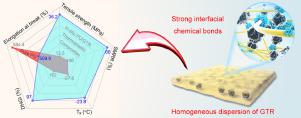Resources, Conservation and Recycling ( IF 11.2 ) Pub Date : 2021-06-10 , DOI: 10.1016/j.resconrec.2021.105713 Maoyong He , Kai Gu , Yulong Wang , Zhenzhong Li , Zhengpeng Shen , Shuai Liu , Jixiang Wei

|
The aim of this paper is to make full use of the hydroxyl groups on the ground tire rubber (GTR) surface to realize the high valuable utilization of waste tires in the field of high-performance polyurethane elastomers. In this work, the Polyurethane/Ground tier rubber (PU/GTR) thermoplastic composite with excellent performance was in-situ synthesized by adding untreated GTR to polyurethane. With incorporating 3.44 wt% GTR to polyurethane, the tensile strength of the PU/GTR thermoplastic composites was improved by approximately 166.7 % compared with pure PU. And the dynamic heat generation index (ratio of the tan δ at 90 °C and 30 °C) of the thermoplastic composites was reduced to 0.97, being far lower than that of pure PU (1.62), which exhibits this material has low dynamic heat generation when subjected to alternating stress. As expected, X-ray photoelectron spectra (XPS) results showed that the GTR indeed participated in the in-situ synthesis of polyurethane, thus, resulting in the GTR particles with micro size being evenly distributed in the polyurethane matrix via a network structure, which was proved by the morphology analysis and rheological measurement part. Additionally, the microphase separation of the PU matrix of the composites was greatly weakened according to Cole-Cole plots and the small angle X-ray scattering (SAXS) analysis. And the outcome of the study provided a low-cost and rational approach for recycling of waste tires while avoiding resource waste.
中文翻译:

原位合成开发基于聚氨酯和轮胎橡胶的高性能热塑性复合材料
本文旨在充分利用磨碎的轮胎橡胶(GTR)表面的羟基,实现废旧轮胎在高性能聚氨酯弹性体领域的高价值利用。在这项工作中,通过将未经处理的 GTR 添加到聚氨酯中,原位合成了具有优异性能的聚氨酯/地层橡胶 (PU/GTR) 热塑性复合材料。通过在聚氨酯中加入 3.44 wt% 的 GTR,与纯 PU 相比,PU/GTR 热塑性复合材料的拉伸强度提高了约 166.7%。并且热塑性复合材料的动态生热指数(90℃和30℃的tanδ之比)降至0.97,远低于纯PU(1.62),表明该材料具有较低的动态生热在交变应力作用下产生。正如预期的那样,X射线光电子能谱(XPS)结果表明,GTR确实参与了聚氨酯的原位合成,从而导致微尺寸的GTR颗粒通过网络结构均匀分布在聚氨酯基体中,这证明了形态分析和流变测量部分。此外,根据 Cole-Cole 图和小角 X 射线散射 (SAXS) 分析,复合材料的 PU 基体的微相分离大大减弱。研究结果为废旧轮胎的回收利用提供了一种低成本、合理的方法,同时避免了资源浪费。导致微尺寸的GTR颗粒通过网络结构均匀分布在聚氨酯基体中,形态分析和流变测量部分证明了这一点。此外,根据 Cole-Cole 图和小角 X 射线散射 (SAXS) 分析,复合材料的 PU 基体的微相分离大大减弱。研究结果为废旧轮胎的回收利用提供了一种低成本、合理的方法,同时避免了资源浪费。导致微尺寸的GTR颗粒通过网络结构均匀分布在聚氨酯基体中,形态分析和流变测量部分证明了这一点。此外,根据 Cole-Cole 图和小角 X 射线散射 (SAXS) 分析,复合材料的 PU 基体的微相分离大大减弱。研究结果为废旧轮胎的回收利用提供了一种低成本、合理的方法,同时避免了资源浪费。











































 京公网安备 11010802027423号
京公网安备 11010802027423号